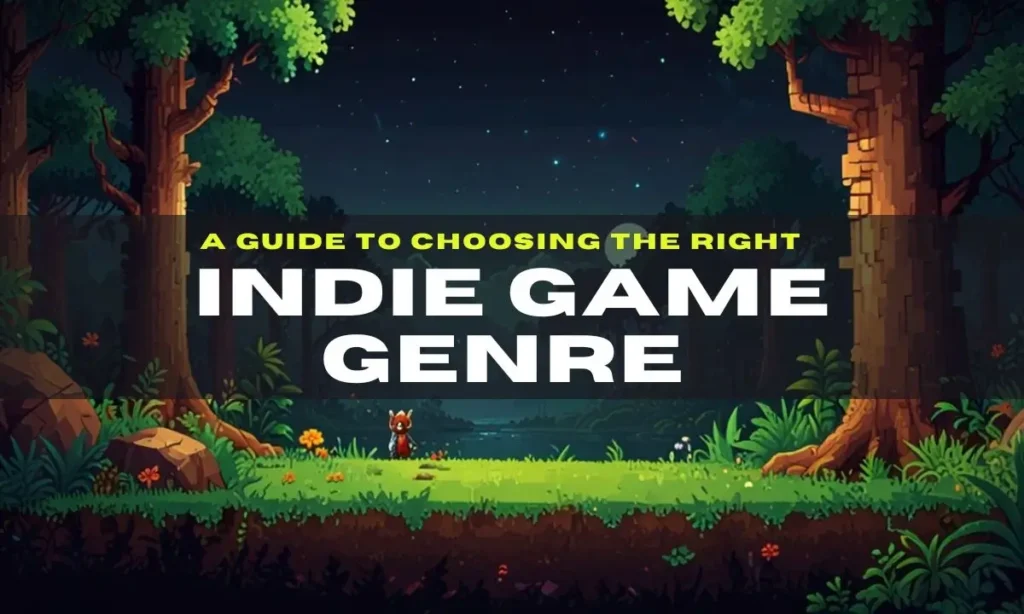Indie games have become a big part of the gaming industry. These games often bring new ideas and fresh gameplay because indie developers don’t have to follow the usual big-budget trends. They can focus on creative storytelling, interesting mechanics, or unique art styles.
In this blog, we will explore the most popular indie game genres and what makes them stand out.
Action-Adventure
Action-adventure games are a hybrid genre that combines key elements of both action and adventure genres. Players navigate through intricate worlds, solve puzzles, and engage in combat, all while being deeply immersed in a compelling narrative. This genre provides the perfect balance of challenge and storytelling, which is why it’s been so successful in the indie game space.
Indie developers often use action-adventure as a vehicle to tell unique stories, leveraging the genre’s flexibility to craft experiences that are rich in both atmosphere and mechanics.
Key Features of Indie Action-Adventure Games
- Exploration: Open worlds or interconnected environments that encourage players to explore, find secrets, and engage with the story through environmental storytelling.
- Puzzles: A mix of mental challenges that are organically embedded within the gameplay, often requiring logical thinking and problem-solving.
- Combat Mechanics: Real-time action sequences that may include platforming, melee, or ranged attacks.
- Narrative Depth: Rich stories that unfold through dialogue, interactions, and cutscenes, often tackling themes that are personal, emotional, or existential in nature.
Why Choose Action-Adventure?
Indie developers often focus on creativity and narrative-driven experiences that differentiate their games from mainstream AAA titles. Action-adventure games allow these developers to explore nuanced storytelling while engaging players with mechanics that feel rewarding. They can create deeply atmospheric worlds, often with distinctive art styles and music that enhance immersion. This genre also allows for unique pacing, with moments of intense action interspersed with quieter, reflective segments. Indie developers use this structure to emphasize mood, character development, and world-building, which all contribute to the player’s emotional connection with the game.
Popular Examples in Indie Action-Adventure
- Hollow Knight: A beautifully hand-drawn action-adventure game with Metroidvania elements, where players explore a vast, interconnected world filled with challenges.
- Celeste: A narrative-driven platformer that blends tight controls with emotional storytelling.
Rogue-Like and Rogue-Lite
Rogue-like and Rogue-lite games are sub-genres of action-adventure where players face procedurally generated levels and permanent death mechanics, meaning if you die, you start over. Rogue-likes stick closely to these core features, while Rogue-lites offer more flexibility, often allowing players to retain some progression, such as unlocked abilities or equipment, between attempts.
These games focus on providing tough challenges, but in return, they reward players with a strong sense of progression and mastery. Indie developers have embraced this genre for its ability to deliver a lot of gameplay variety with relatively simple core mechanics.
Key Features of Indie Rogue-Likes and Rogue-Lites
- Permadeath: When the player dies, they lose everything and must start again. This feature pushes players to learn from their mistakes and encourages a high replay value.
- Procedurally Generated Levels: Levels are randomly generated, meaning no two playthroughs are the same. This keeps the gameplay fresh and unpredictable.
- Replayability: These games often provide incentives for multiple playthroughs by introducing unlockable abilities, characters, or new weapons.
- Skill-Based Combat: Often the focus is on honing player skills, as success is based on fast decision-making and tactical execution.
Why Choose Rogue-Likes/Rogue Lite?
Indie developers have found Rogue-likes and Rogue-lites to be a great fit for small teams, as they offer high replay value with relatively simple mechanics. The procedural generation in these games means that developers can offer endless gameplay variety without the need to hand-craft every level. Additionally, the genre’s emphasis on difficulty appeals to players who enjoy mastering games over time. Rogue-likes also allow indie developers to innovate. Each game can introduce its own twist on the mechanics, such as integrating narrative elements or adding new ways to interact with the environment. This makes the genre highly flexible, encouraging creativity.
Popular Examples in Indie Rogue-Likes
- Hades: A critically acclaimed rogue-lite that merges fast-paced combat with a rich narrative based on Greek mythology.
- Dead Cells: A rogue-lite Metroidvania that combines platforming with action, offering endless replayability through procedurally generated levels.
Puzzle Games
Puzzle games are a natural fit for indie developers. These games emphasize intellectual challenges, rewarding players for problem-solving, logic, and attention to detail. In puzzle games, the core mechanics focus on figuring out solutions, and they often push players to think creatively. Indie puzzle games frequently mix in elements from other genres, such as exploration or storytelling, to create a deeper experience.
The simplicity of the mechanics allows indie developers to focus on game design and creativity rather than large budgets or complex graphics.
Key Features of Indie Puzzle Games
- Brain Teasers and Logical Challenges: The gameplay centers around solving puzzles, which can range from simple riddles to complex logic problems.
- Exploration Elements: Some puzzle games, especially 3D ones, include exploring environments to find clues or pieces of a larger puzzle.
- Minimalism in Design: Many indie puzzle games opt for a minimalist art style to keep the focus on the puzzle-solving aspect.
- Innovation in Mechanics: Indie puzzle games often bring unique and creative mechanics, offering players a fresh take on how puzzles are integrated into the gameplay.
Why Choose Puzzle Games?
Puzzle games don’t need complex graphics or huge budgets to engage players. Instead, they rely on innovative mechanics and clever level design. This makes them perfect for indie developers who want to focus on creativity. The genre also encourages experimentation; developers can create entirely new types of puzzles or add narrative elements to enhance the gameplay.
Because puzzles challenge the player’s intellect rather than reflexes, they appeal to a broad audience, making them one of the most accessible indie game genres.
Popular Examples in Indie Puzzle Games
- World of Goo 2: Highly rated and loved for its physics-based puzzles where players connect goo balls to build structures. It’s a sequel to the original World of Goo, known for its innovation and creativity.
- Boxes: Lost Fragments: This adventure puzzle game has earned praise for its emotional depth combined with intricate puzzle mechanics, challenging players to piece together fragmented memories.
- Animal Well: A visually stunning puzzle-platformer that uses lighting and exploration as key puzzle elements, making it both a visual and mental delight.
Simulation and Management
Simulation and management games let players create, manage, or control various systems, such as cities, farms, or even societies. These games often provide a sense of progression and accomplishment, which is highly appealing for players who enjoy long-term planning and strategy. Indie developers, with their ability to focus on niche interests, have taken the genre in many exciting directions, creating immersive experiences with unique twists.
Indie simulation games frequently mix with other genres, offering more than just building or resource management. For instance, some games combine exploration, crafting, or even survival elements, which adds layers to the gameplay.
Key Features of Indie Simulation and Management Games
- Resource Management: Players manage resources such as money, food, or materials to grow their in-game environments or characters.
- Customization: Whether building a farm, city, or business, players have a high degree of control over how they develop their projects.
- Long-Term Strategy: These games focus on gradual progress and often involve balancing short-term needs with long-term goals.
- Open-Ended Gameplay: Many indie simulation games have sandbox-style modes, allowing players to approach objectives in their own way, without strict linear progression.
Why Choose Simulation?
Indie developers are not constrained by mainstream trends, which allows them to focus on creative ideas that may not be explored by larger studios. The genre’s flexibility also fits smaller development teams, as they can implement detailed systems and player-driven narratives without the need for high-end graphics. Simulation games often have a loyal fan base that appreciates depth and replayability, both of which are hallmarks of indie titles.
Indie simulation games are especially popular because they provide relaxing yet engaging gameplay. Players can focus on long-term planning and enjoy watching their creations grow, whether they are managing a farm, a city, or even a space colony.
Popular Examples in Indie Simulation and Management
- Lightyear Frontier: A unique mix of farming simulation and exploration set in outer space, offering a blend of resource management and adventure.
- Manor Lords: A city-building simulator where players manage a medieval village with realistic building mechanics, combining strategy with historical accuracy.
- Strange Horticulture: A simulation game where players run a mysterious plant shop, solving puzzles and uncovering dark secrets, highly praised for its clever design and storytelling.
Platformers
Indie platformers are a genre where players navigate characters through levels, avoiding obstacles and enemies, and using precise timing and reflexes to complete challenges. While platformers were originally popular in the early days of gaming, indie developers have revived and innovated this genre in recent years, adding unique twists in gameplay, narrative, and visual style.
Indie platformers often focus on tight controls and challenge, with some games emphasizing exploration and puzzle-solving elements. This makes the genre versatile and appealing to a broad audience.
Key Features of Indie Platformers
- Tight Controls: Precision in movement and actions is essential, requiring players to master jumping, dodging, and other maneuvers.
- Challenging Gameplay: Often, indie platformers are known for their difficulty, offering levels that test the player’s skill and patience.
- Innovative Art Styles: These games typically feature visually distinct aesthetics, ranging from pixel art to hand-drawn animations.
- Narrative Depth: Many modern indie platformers incorporate deep stories, often touching on themes like personal growth, struggle, or loss.
Why Choose Platformers?
Indie platformers allow developers to experiment with new ideas while keeping gameplay mechanics simple. Many platformers focus on tight gameplay loops, giving players immediate feedback as they progress through increasingly challenging levels. This genre also allows for smaller development teams, as developers can concentrate on level design, animation, and storytelling, without requiring large production budgets for complex 3D worlds.
Additionally, platformers are easy to learn but hard to master, which keeps players engaged and encourages community interaction through speedrunning, mods, and fan discussions.
Popular Examples in Indie Platformers
- Celeste: A critically acclaimed platformer known for its challenging levels and emotional narrative. The game has been highly praised for its tight controls and rewarding gameplay.
- Hollow Knight: A mix of Metroidvania and platforming, Hollow Knight is lauded for its exploration, challenging combat, and beautiful hand-drawn world.
- Aerial_Knight’s Never Yield: This fast-paced narrative platformer uses parkour-style movement and stylish visuals, offering something unique in the genre.
- BlazBlue Entropy Effect: Combining platforming with roguelike elements, this game stands out for its dynamic combat and procedurally generated levels.
Horror
Why Indie Horror Games Stand Out
Indie horror games have become a popular genre due to their ability to evoke fear and suspense through atmosphere, storytelling, and minimalistic designs. These games focus less on big-budget graphics and more on psychological horror, sound design, and pacing, which helps to create an immersive, unsettling experience. Indie developers often use simple mechanics, but through creative execution, they deliver deeply terrifying and engaging experiences.
Indie horror titles often explore niche themes and experimental ideas that mainstream horror games may shy away from, making them unique and unpredictable. This flexibility allows indie developers to create terrifying atmospheres that push the boundaries of conventional horror.
Key Features of Indie Horror Games
- Psychological Horror: These games often focus on unsettling environments and psychological tension, with players experiencing dread through atmosphere and narrative.
- Minimalism: Many indie horror games opt for simple graphics and mechanics, focusing instead on tension-building through lighting, sound, and pacing.
- Exploration and Mystery: Many games emphasize exploring eerie locations and solving puzzles, often revealing dark, hidden stories.
- Unique Themes: From haunted houses to dystopian futures, indie horror explores diverse and often unconventional settings and storylines.
Why Choose Horror?
Indie developers have the freedom to explore unconventional and experimental horror concepts. They can create highly personalized and emotionally charged experiences, offering players something fresh in a genre that is often dominated by predictable jump scares in mainstream titles. These games usually involve complex storytelling, with an emphasis on exploration and psychological horror, rather than combat-heavy experiences.
Players are drawn to indie horror for the intensity of the experience and the creativity in how the games present their fears. Indie horror often connects with players on a deeper emotional level by relying on subtle horror elements rather than overt gore or violence.
Popular Examples in Indie Horror Games
- Soma: A sci-fi horror game that focuses on the philosophical implications of consciousness and identity, set in an underwater facility, creating a deeply immersive and haunting experience.
- 9 Childs Street: This first-person horror game places you in the shoes of a curious 9-year-old boy, adding a unique perspective to the exploration of a haunted house.
- Rewind or Die: A throwback to classic slasher horror, this game puts players in a video rental store during a terrifying serial killer hunt.
Survival
What Defines Indie Survival Games?
Indie survival games focus on players managing resources, maintaining health, and navigating hostile environments. These games often combine crafting, exploration, and combat, pushing players to make tough decisions in challenging situations. Unlike mainstream survival games, indie survival games are known for their unique settings and creative mechanics, which often incorporate elements like exploration, building, and even psychological survival.
In this genre, the key is managing limited resources while avoiding dangers such as environmental threats, creatures, or even other players in multiplayer modes.
Key Features of Indie Survival Games
- Resource Management: Players must gather materials and food while balancing their immediate needs like hunger and shelter.
- Crafting Systems: Crafting tools, weapons, and structures is central to survival, requiring players to prioritize resource usage.
- Open-Ended Gameplay: Many survival games feature procedurally generated worlds, making each playthrough unique and unpredictable.
- Exploration: Survival games often feature large, open environments that players must explore to gather resources and uncover hidden secrets.
Why Choose Survival?
Indie developers are able to experiment with survival mechanics that are often overlooked by larger studios. For example, some indie survival games like The Long Dark focus purely on environmental survival without the typical zombie or monster threats, making the experience more about battling nature than supernatural forces. This gives players a more realistic survival experience. Indie developers also create games that mix survival with other genres, such as strategy, crafting, and even storytelling, which leads to rich, layered gameplay.
Popular Examples in Indie Survival Games
- The Long Dark: This atmospheric survival game places players in a Canadian wilderness post-apocalypse, where they must fight the elements to survive.
- Raft: A co-op survival game set in the middle of the ocean, where players must build a floating base while fending off sharks and gathering resources.
- Don’t Starve: A dark, cartoony wilderness survival game where players must craft, gather food, and stave off madness to survive. Its expansion, Don’t Starve Together, adds a multiplayer aspect to the experience.
Narrative-Driven and Visual Novels
Narrative-driven games and visual novels focus primarily on storytelling, where the plot and characters are the central aspects of the experience. Gameplay in these genres is often simple, involving dialogue choices, puzzles, or point-and-click mechanics. The genre emphasizes narrative depth and emotional engagement, making them popular among players who prioritize story over action.
Indie developers have embraced these genres because they allow for creative storytelling without the need for complex mechanics or expensive visuals. Visual novels, in particular, are known for their anime-inspired art styles, interactive storytelling, and branching narratives, where player choices directly impact the outcome of the game.
Key Features of Narrative-Driven and Visual Novels
- Strong Emphasis on Story: The narrative takes precedence over gameplay, with deep character development and emotional arcs.
- Interactive Choices: Players often make decisions that affect the story’s direction, leading to multiple endings or changes in character relationships.
- Minimal Gameplay Mechanics: The gameplay is usually limited to dialogue options, exploration, or light puzzles, allowing the story to remain the focal point.
- Art and Presentation: Visual novels often feature hand-drawn or anime-style artwork to support the storytelling, creating an immersive and visually appealing experience.
Why Choose Narrative-Driven or Visual Novels?
Indie developers thrive in the narrative-driven genre because it allows them to focus on writing and character development without needing a large budget for complex gameplay systems. The flexibility to explore mature, emotional, or niche themes without mainstream constraints is another reason why this genre flourishes in the indie space. Indie developers can create highly personal or experimental stories that would not fit into the traditional AAA gaming mold.
Many narrative-driven indie games and visual novels also explore unique themes like mental health, existential crises, and intimate relationships, resonating with players who seek meaningful and thought-provoking experiences.
Popular Examples in Narrative-Driven and Visual Novels
- Night in the Woods: A narrative-driven adventure game that explores complex themes like mental health, friendship, and small-town life through rich storytelling and engaging dialogue.
- Oxenfree: A supernatural thriller where the story is driven by player choices, with dialogue influencing character relationships and multiple endings.
- The Red Strings Club: A cyberpunk narrative-driven game focusing on philosophical themes such as free will, emotions, and technology.
Final Thoughts
Indie games have become a powerhouse in the gaming industry, largely due to their creative freedom and unique approach to game design. From action-adventure to survival, indie developers continually push boundaries, offering fresh, innovative experiences that cater to niche audiences and casual players alike. The indie scene allows for experimentation, blending genres, and tackling complex themes that might be overlooked by larger studios.
Indie games also offer diversity in gameplay styles and mechanics, as seen in popular genres like rogue-likes, puzzle games, platformers, and simulation. These games provide memorable experiences without needing massive budgets or mainstream appeal. They often resonate deeply with players because of their focus on creativity, storytelling, and challenging gameplay. As the indie game scene continues to grow, more genres will emerge, and hybrid genres will continue to innovate the gaming landscape. Whether you’re drawn to the narrative depth of platformers like Celeste, the intellectual challenges of puzzle games like The Witness, or the tense survival dynamics of The Long Dark, there’s an indie game for every type of player.



